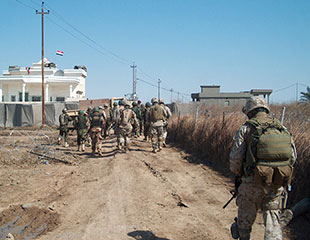Healing to Live; Living to Heal
2-minute read
Healing to Live; Living to Heal
2-minute read
Aaron woke up one morning and noticed plumes of smoke rising in the distance. The Navy Corpsman, serving in Iraq as part of a security detachment, had been in this new location for just a few hours. The smoke drew Aaron outside, just as a mortar landed about 30 feet away.
That trauma and others he experienced during his two decades in the U.S. Navy led him down a difficult path after he transitioned out of the military.
Aaron says he was “going through life numb.” He decided to distance himself from his wife, children, and friends, thinking that if he weren’t attached to people, it would hurt less if he lost them. Aaron had been going through the motions for about a year when he realized he had become quick to anger.
Looking back, he explains that he acted out but wasn’t necessarily angry.
“I needed to feel that angry to hit a peak where I was feeling like things were intense,” he explains. “I need that intensity a little bit and then I’d come down from it.”

I was going through life numb
He also started having nightmares. They were so realistic and upsetting that Aaron would wake up and call to check on the people he lost in his dreams.
It was Aaron’s wife who encouraged him to get counseling. He resisted, thinking he was in control because he was still able to help his fellow Veterans. But eventually, Aaron agreed to talk to a psychologist. In that first visit, he unexpectedly broke down in tears, which convinced him that he needed to stick with the therapy.
“I had to heal from the body, and I also had to heal from the mind, too,” he says. “That’s part of what happened.”
Aaron also joined some Veterans groups where he learned from the experiences — good and bad — of other combat survivors. He understood their stories, and they were able to put words to Aaron’s thoughts and emotions in a way that he couldn’t. He also learned about the tools for healing that worked and didn’t work for the men in his group.
“To listen to other guys and situations and realize those are paths probably I don’t want to go down” was a wake-up call, Aaron says. “I could see myself heading that way if I didn’t have his insight.”
Ultimately, Aaron came to a completely new conclusion about life. Instead of living in a defensive posture, detaching from people to protect himself, Aaron needed to play offense and start living for something.
“I had to find little tickets of hope in every step of my way,” Aaron says. He encourages his fellow Veterans to identify “something to believe in, or hope, or a wife, or family that care about you.” Doing that, he says, “set me on a path of betterness.”
Aaron manages his fleeting feelings of numbness in part to honor fallen Service members.
“I wear this Purple Heart on my hat to remember those guys that are buried with theirs,” Aaron says. “At any given time, they would love to switch places with us, but they can’t. It’s our duty to live up to their desire to see their family and friends and people.”
